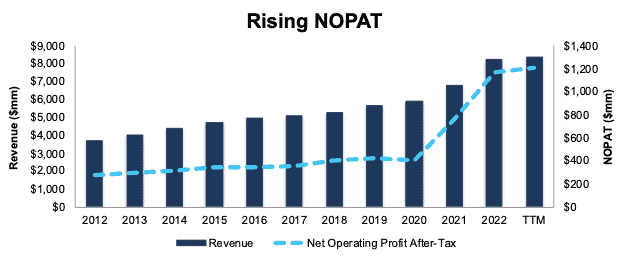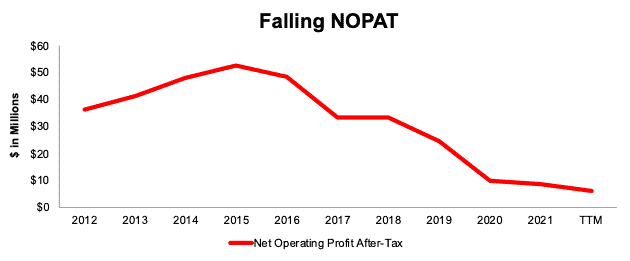July Performance Recap
Our Most Attractive Stocks (+8.8%) outperformed the S&P 500 (+5.5%) from July 7, 2022 through August 1, 2022 by 3.3%. The best performing large cap stock gained 33% and the best performing small cap stock was up 31%. Overall, 27 out of the 40 Most Attractive stocks outperformed the S&P 500.
Our Most Dangerous Stocks (+7.9%) underperformed the S&P 500 (+.5.5%) as a short portfolio from July 7, 2022 through August 1, 2022 by 2.4%. The best performing large cap short stock fell by 12%, and the best performing small cap short stock fell by 18%. Overall, 14 out of the 36 Most Dangerous stocks outperformed the S&P 500 as shorts.
The Most Attractive/Most Dangerous Model Portfolios outperformed as an equal-weighted long/short portfolio by 0.9%.
This report leverages our cutting-edge Robo-Analyst technology to deliver proven-superior[1] fundamental research and support more cost-effective fulfillment of the fiduciary duty of care.
Fourteen new stocks made our Most Attractive list this month, and thirteen new stocks also fell onto the Most Dangerous list. August’s Most Attractive and Most Dangerous stocks were made available to members on August 3, 2022.
Our Most Attractive stocks all have high and rising return on invested capital (ROIC) and low price to economic book value ratio. Most Dangerous stocks have misleading earnings and long growth appreciation periods implied by their market valuations.
Most Attractive Stocks Feature for August: Williams-Sonoma (WSM: $155/share)
Williams-Sonoma is the featured stock from August’s Most Attractive Stocks Model Portfolio.
Williams-Sonoma has grown revenue by 8% compounded annually and net operating profit after-tax (NOPAT) by 16% compounded annually over the past ten years. Williams-Sonoma’s NOPAT margin has increased from 7% in fiscal 2012 to 14% over the trailing-twelve-months (TTM), while invested capital turns rose from 1.5 to 2.8 over the same time. Rising NOPAT margins and invested capital turns drive the company’s return on invested capital (ROIC) from 11% in 2012 to 41% over the TTM.
Figure 1: Revenue & NOPAT Since 2012
Sources: New Constructs, LLC and company filings
COVID-driven acceleration of ecommerce and the work-from-home trend boosts Williams-Sonoma’s TTM NOPAT as it did many firms. As detailed in our last report, we believe Williams-Sonoma’s strong omni-channel operation positions it to continue to take share and outperform even after the COVID boost to its business fades.
Williams-Sonoma Is Undervalued
At its current price of $155/share, WSM has a price-to-economic book value (PEBV) ratio of 0.7. This ratio means the market expects Williams-Sonoma’s NOPAT to permanently decline by 30%. This expectation seems overly pessimistic for a company that grew NOPAT by 16% compounded annually over the past decade and 14% compounded annually over the past two decades.
Even if Williams-Sonoma’s NOPAT margin falls to 10% (vs. 14% TTM) and the company grows NOPAT by less than 1% compounded annually for the next decade, the stock would be worth $212/share today – a 37% upside. See the math behind this reverse DCF scenario. Should Williams-Sonoma grow profits more in line with historical levels, the stock has even more upside.
Critical Details Found in Financial Filings by Our Robo-Analyst Technology
Below are specifics on the adjustments we made based on Robo-Analyst findings in Williams-Sonoma’s 10-Qs and 10-K:
Income Statement: we made $81 million in adjustments, with a net effect of removing $41 million in non-operating expenses (<1% of revenue). Clients can see all adjustments made to Williams-Sonoma’s income statement on the GAAP Reconciliation tab on the Ratings page on our website.
Balance Sheet: we made $828 million in adjustments to calculate invested capital with a net decrease of $512 million. One of the most notable adjustments was $133 million in asset write-downs. This adjustment represented 5% of reported net assets. Clients can see all adjustments made to Williams-Sonoma’s balance sheet on the GAAP Reconciliation tab on the Ratings page on our website.
Valuation: we made $1.2 billion of adjustments with a net effect of decreasing shareholder value by $1.2 billion. The largest adjustment to shareholder value was $1.2 billion in total debt. This adjustment represents11% of Williams-Sonoma’s market cap. Clients can see all adjustments to Williams-Sonoma’s valuation on the GAAP Reconciliation tab on the Ratings page on our website.
Most Dangerous Stocks Feature: Fiesta Restaurant Group (FRGI: $8/share)
Fiesta Restaurant Group (FRGI) is the featured stock from August’s Most Dangerous Stocks Model Portfolio.
Fiesta Restaurant Group’s NOPAT has fallen from $53 million in 2015 to just $6 million over the TTM. The company’s NOPAT margin has fallen from 8% to 2%, while invested capital turns fell from 1.0 to 0.5 over the same time. Falling NOPAT margins and invested capital turns drive Fiesta Restaurant Group’s ROIC from 8% in 2015 to 1% TTM. Economic earnings, the true cash flows of the business, have also fallen from $12 million in 2015 to negative -$20 million over the TTM.
Figure 2: NOPAT Since 2012
Sources: New Constructs, LLC and company filings
Fiesta Restaurant Group Provides Poor Risk/Reward
Despite its poor fundamentals, Fiesta Restaurant Group’s stock is priced for significant profit growth, and we believe the stock is overvalued.
To justify its current price of $8/share, Fiesta Restaurant Group must improve its NOPAT margin to 5% (compared to 2% TTM and five years of NOPAT decline prior to the pandemic) and grow NOPAT by 12% compounded annually for the eight years. See the math behind this reverse DCF scenario. 5% NOPAT CAGR may not seem like much, except for the fact that Fiesta Restaurant Group’s NOPAT fell year-over-year every year from 2016-2021, and TTM NOPAT is down 55% over the prior year period, which makes these expectations look overly optimistic.
Even if Fiesta Restaurant Group can achieve maintain its TTM NOPAT margin of 2% and grow NOPAT by 3% compounded annually for the next decade, the stock would be worth less than $1/share today – a 96% downside to the current stock price. See the math behind this reverse DCF scenario.
Each of these scenarios also assumes Fiesta Restaurant Group can grow revenue, NOPAT, and FCF without increasing working capital or fixed assets. This assumption is unlikely but allows us to create truly best-case scenarios that demonstrate how high expectations embedded in the current valuation are.
Critical Details Found in Financial Filings by Our Robo-Analyst Technology
Below are specifics on the adjustments we made based on Robo-Analyst findings in Fiesta Restaurant Group’s 10-Qs and 10-K:
Income Statement: we made $38 million in adjustments, with a net effect of removing $2 million in non-operating income (1% of revenue). Clients can see all adjustments made to Fiesta Restaurant Group’s income statement on the GAAP Reconciliation tab on the Ratings page on our website.
Balance Sheet: we made $317 million in adjustments to calculate invested capital with a net increase of $279 million. One of the most notable adjustments was $160 billion in asset write-downs. This adjustment represented 49% of reported net assets. Clients can see all adjustments made to Fiesta Restaurant Group’s balance sheet on the GAAP Reconciliation tab on the Ratings page on our website.
Valuation: we made $235 million in adjustments, with a net decrease to shareholder value of $191 million. Apart from total debt, the most notable adjustment to shareholder value was $22 million in excess cash. This adjustment represents 11% of Fiesta Restaurant Group’s market cap. Clients can see all adjustments to Fiesta Restaurant Group’s valuation on the GAAP Reconciliation tab on the Ratings page on our website.
This article originally published on August 11, 2022
Disclosure: David Trainer, Kyle Guske II, Matt Shuler, and Brian Pellegrini receive no compensation to write about any specific stock, style, or theme.
Follow us on Twitter, Facebook, LinkedIn, and StockTwits for real-time alerts on all our research.
[1] Our research utilizes our Core Earnings, a more reliable measure of profits, as proven in Core Earnings: New Data & Evidence, written by professors at Harvard Business School (HBS) & MIT Sloan and published in The Journal of Financial Economics.


